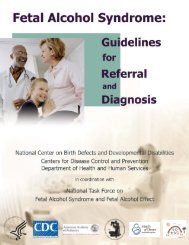FETAL ALCOHOL SPECTRUM DISORDERS florida resource guide
FETAL ALCOHOL SPECTRUM DISORDERS florida resource guide
FETAL ALCOHOL SPECTRUM DISORDERS florida resource guide
- No tags were found...
You also want an ePaper? Increase the reach of your titles
YUMPU automatically turns print PDFs into web optimized ePapers that Google loves.
SECTION 1Overview of FetalAlcohol SpectrumDisordersFetal Alcohol SyndromeFetal Alcohol Syndrome (FAS) is a constellation of physical, cognitive,and behavioral abnormalities caused by prenatal exposure to alcohol(Jones, Smith, Ulleland, & Streissguth, 1973). FAS is defined by fourcriteria: prenatal alcohol consumption, characteristic facialabnormalities, growth retardation, and brain damage that results inintellectual difficulties or behavior problems.FAS is highly individualized. Some babies are born with severe physicalanomalies and mental retardation; others are only slightly affected(Streissguth, 1997). In addition to the abnormal facial features, pre andpostnatal growth abnormalities, and mental retardation that define thecondition, approximately 80 percent of children with FAS displaybehavior problems. As many as 50 percent of affected children alsoexhibit poor coordination, attention-deficit hyperactivity disorder,decreased fatty tissue, and identifiable facial anomalies such as cleftpalate, and abnormal smallness of jaw. Cardiac defects, hermangiomas(biologically active birthmarks) and eye or ear abnormalities are alsocommon (American Academy of Pediatrics, 2000).Like most birth defects, FAS is a lifelong condition. While the mosteasily recognizable, growth and facial features are not really the essenceof FAS, they are simply early markers that, in combination withCentral Nervous System (CNS) effects, embody the collection offeatures that characterize the syndrome. The real long-term disabilityof FAS is the CNS dysfunction that is critical in the diagnosis of theolder individual, for whom the growth and facial features may be lessnoticeable (Streissguth, 1997).Evidence of possible CNS abnormalities includes:▪ Head circumference below the third percentile▪ Developmental delays▪ Poor impulse control▪ Inconsistent knowledge base▪ Difficulty grasping abstract concepts▪ Speech/language disorders▪ Problems with perception, sensory integration, and tactiledefensiveness▪ Hyperactivity▪ Learning disabilities▪ DistractibilitySee Section 4, Diagnosis of FAS, for further information.8 <strong>FETAL</strong> <strong>ALCOHOL</strong> <strong>SPECTRUM</strong> <strong>DISORDERS</strong> <strong>florida</strong> <strong>resource</strong> <strong>guide</strong>



